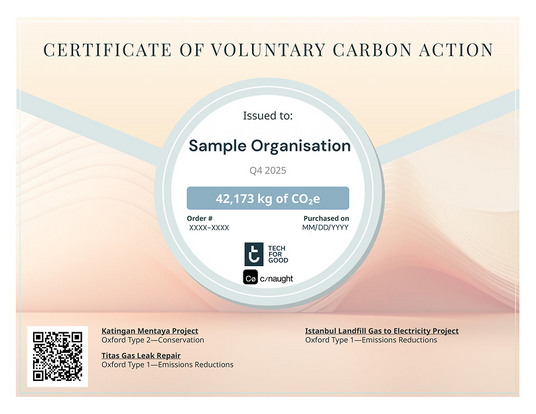Why Carbon Neutral IT Procurement Matters
ICT has become one of the most challenging categories for organisations seeking to manage their climate footprint. Globally, the sector accounts for 2–4% of total greenhouse gas emissions, already comparable to aviation. Yet unlike energy or transport, most ICT emissions are invisible to day-to-day users.
The problem lies in the shape of ICT’s footprint. Lifecycle analyses consistently show that 70–80% of a laptop’s emissions are embodied in manufacture. By the time equipment arrives in your office, most of its carbon cost has already been incurred. This makes ICT procurement one of the hardest Scope 3 categories to address, since traditional reduction levers like efficiency or behaviour change have minimal impact.
The scale of emissions is material. Replacing 1,000 laptops produces around 316 tonnes of CO₂e — equivalent to the annual footprint of 70 Australian households. For large organisations with regular fleet refresh cycles, this quickly adds up to thousands of tonnes of Scope 3 emissions.
At the same time, compliance obligations are tightening:
- ASRS (from FY25): Large Australian entities must disclose Scope 1, 2, and 3 emissions. ICT procurement will be one of the first categories auditors look at.
- NGERS: Provides the statutory reporting baselines and emissions data that underpin ASRS assurance processes.
- ASIC: Has warned that generic or vague claims of being “carbon neutral” without verifiable evidence may constitute greenwashing.
This combination of material impact and regulatory scrutiny is why ICT procurement has moved from a background issue to a frontline compliance and ESG challenge.
What Carbon Neutral IT Procurement Actually Delivers
Carbon neutral IT procurement has become a priority for organisations preparing for mandatory sustainability reporting and stricter ESG scrutiny. With embodied emissions making up the majority of ICT’s footprint, procurement teams now need clear evidence, defensible claims and audit-ready pathways — not generic environmental statements.
At the same time, regulators are increasing pressure on organisations to substantiate their carbon-related claims. Most ICT suppliers do not address embodied emissions, offsets, lifecycle data or assurance at all, leaving a major gap in reporting. Buyers need a procurement model that meets compliance expectations and provides real transparency.
TechForGood’s Carbon Neutral IT Procurement model embeds carbon responsibility directly into the procurement event. Each engagement provides measurable, traceable evidence aligned with modern ESG reporting and assurance requirements.
The Embodied Emissions Problem — and Why Procurement Matters
Most of an ICT device’s lifetime emissions occur before it ever reaches the user. Manufacturing, resource extraction, chip production and global logistics account for the bulk of its footprint.
This means:
- emissions cannot be reduced after manufacture
- behavioural change has minimal impact
- procurement becomes the most meaningful ESG intervention point
A carbon neutral ICT strategy begins with how an organisation buys technology — not how it uses it.
Moving from “No Neutrality” to Audit-Ready Evidence
Most ICT suppliers provide no carbon neutrality offering at all.
Where offsets do exist, they are usually:
- purchased in bulk
- disconnected from ICT transactions
- unsupported by lifecycle evidence
- insufficient for assurance
To meet modern expectations, neutrality must be:
- linked to real procurement activity
- supported by supplier data
- transparent and traceable
- backed by named certificates where required
- built for audit, not marketing
TechForGood’s model is designed around evidence — giving organisations a defensible position when reporting, disclosing or undergoing assurance.
The TechForGood Value Chain in Practical Terms
Your existing page introduces the three-tier model: Switch, Enhance and Embed.
Here is what each tier delivers:
Switch — Immediate Access to Carbon Neutral Operations
Switch provides generic carbon neutral coverage by routing ICT procurement through TechForGood’s carbon neutral operations.
No named certificates.
Ideal for organisations needing a fast uplift and a compliant baseline.
Enhance — Transaction-Level Named Certificates
Enhance links carbon offsets directly to specific ICT procurement events.
Named certificates create a clear evidentiary chain for audit, showing how emissions and offsets match each transaction.
Embed — Neutrality Across All ICT Suppliers
Embed extends neutrality across the customer’s entire ICT environment — including mandated panels and preferred suppliers.
TechForGood manages onboarding, alignment and reporting to create an organisation-wide neutrality model.
All tiers can incorporate circular recovery via the Recover-E secure IT asset disposal service, adding recycling, landfill diversion and material recovery data to the ESG profile.
Circularity — The Missing Piece of Carbon Neutral IT
Carbon neutrality alone is not enough.
A credible ICT sustainability model requires a circular lifecycle, where responsibility is embedded at every stage.
A complete circular pathway includes:
- responsible procurement planning
- longer device lifespan and smarter refresh cycles
- secure ISO 27001–aligned collection
- ISO 14001–certified recycling and material recovery
- data destruction with full chain-of-custody
- residual value recovery on reusable assets
- community reinvestment through Catalysing Connections
- transparent, auditable offsetting at the appropriate tier
This approach connects procurement, usage, recovery and reporting — turning ICT into a lifecycle ESG asset, not a linear cost.
Beyond Emissions — Governance, Social Value and Trust
Carbon Neutral IT Procurement through TechForGood delivers measurable benefits across environmental, social and governance dimensions:
Environmental
- e-waste diverted from landfill
- reduced extraction of virgin materials
- lower resource and water impacts
- transaction-linked offsets in Enhance and Embed
Social
- asset value reinvested into Catalysing Connections
- supported employment pathways
- digital inclusion impact
Governance
- evidence and reporting aligned with modern assurance expectations
- transparency and accountability via a B Corp Certified ICT Supplier
- chain-of-custody documentation for IT asset recovery
This creates neutral IT procurement that is real, defensible and socially meaningful — not a checkbox exercise.
How Carbon Neutral IT Procurement Strengthens ESG Performance
Carbon neutral ICT procurement supports:
- sustainability disclosures
- circular economy performance
- Scope 3 reporting quality
- ESG audit readiness
- community outcomes via the Social Procurement ICT Supplier model
It transforms ICT from a high-emission, high-risk category into one of the strongest ESG levers available to organisations today.

The Compliance Challenge for ICT & ESG Leaders
For procurement and ESG leaders, the risks are twofold: material emissions exposure, and weak supplier practices.
Most ICT suppliers:
- Provide no lifecycle or emissions data, leaving procurement teams without Scope 3 inputs.
- Purchase bulk offsets retrospectively, disconnected from actual procurement events.
- Offer no transaction-linked certificates, making neutrality claims unverifiable.
- Fail to manage end-of-life securely, with devices often recycled without ISO assurance.
These gaps create audit risks and reputational exposure. Procurement officers cannot show defensible evidence of neutrality, and ESG teams are left unable to back up ASRS or NGERS disclosures.
This is why ASIC has highlighted ICT as a sector where greenwashing risks are acute: claims are often made, but the evidentiary basis is weak.
How We Substantiate Our Carbon Neutrality Claims
-
What Our Carbon Neutrality Covers
Our certification covers the entire cradle-to-gate emissions profile of every ICT product we sell, as well as our operational emissions. This includes:
- Raw material extraction
- Component manufacturing (e.g., semiconductors, batteries, displays)
- Assembly and testing
- Packaging
- International logistics and upstream transport
- Distribution to TechForGood
- TechForGood’s own Scope 1, 2, and relevant Scope 3 operational emissions
-
How We Quantify Emissions
Our annual GHG inventory is prepared in accordance with the Greenhouse Gas Protocol, using activity-based and spend-based inputs, and is independently verified for accuracy.
-
How We Offset Emissions
TechForGood purchases and retires carbon credits equal to 100% of its total emissions each year through high-integrity registries including:
- Verra VCS
- Gold Standard
- Climate Action Reserve
Projects include methane abatement, peatland protection, forest conservation, biodiversity restoration, and Indigenous-led land stewardship.
-
Public Transparency & Evidence
We publish our:
- Annual Greenhouse Gas Emissions Report
- Carbon Neutral Certificate
- Carbon Neutrality & Offsets Policy
- Impact Report (with offset portfolio disclosures)
These documents provide the evidence base required for ASRS, NGERS and ESG assurance.
-
Annual Renewal & Assurance
Carbon neutrality is reviewed and re-certified annually, with public retirement of offsets and rigorous oversight of boundaries, methodology and emissions calculations.
Our 997 t CO₂e offsets to date
Equivalent to any ONE of the following examples (not additive):
-
 3012Laptops
3012Laptops -
 6646AI business users
6646AI business users -
 830Cloud compute servers
830Cloud compute servers -
 12100-person offices
12100-person offices
How we calculate these equivalences
TechForGood has offset 997 t CO₂e. To make this tangible, we show four non-additive examples. Each example expresses the same impact in ICT and workplace terms.
Simple formula
We convert tonnes into kilograms, divide by a benchmark factor, then round to whole numbers:
equivalent_count = round( ( total_tonnes × 1000 ) ÷ factor_kg_per_unit )
Benchmarks used
-
Laptop — 331 kg CO₂e per device
Includes embodied manufacturing plus typical operation, annualised.997 t CO₂e ≈ 3012 laptops.
-
AI business user (1 year) — 150 kg CO₂e per user-year
Typical office user AI activity over one year.997 t CO₂e ≈ 6646 user-years.
-
Cloud compute server (1 year) — 1200 kg CO₂e per server-year
Assumes average utilization and grid-average electricity.997 t CO₂e ≈ 830 server-years.
-
100-person office (1 year) — 80000 kg CO₂e per office-year
Electricity and shared services only. Excludes commuting and embodied fit-out.997 t CO₂e ≈ 12 office-years.
Scope, assumptions and caveats
- Not additive: examples describe the same offset, not additional impacts.
- Annualised proxies: factors are per year to aid comprehension.
- Rounded values: whole numbers to avoid false precision.
- Regional variation: results vary by geography, energy mix, and workload.
- Embodied vs use-phase: laptops include embodied emissions; servers and offices are mainly operational energy.
- No financials: this block does not refer to costs or savings.
See factor notes and sources
- Laptop: embodied + typical operation, industry synthesis.
- AI user: typical office usage proxy.
- Server: annualised cloud compute proxy.
- Office: 100-person office energy proxy.
Region: AU (grid-average) · Last reviewed: 09/2025

Transaction-Linked Carbon Offset Certificates
Public, read-only statement. Benchmarks are indicative and for equivalence only.
Example of a transaction-linked, named certificate issued every six months at Enhance/Embed.
Your ICT Carbon Footprint— aligned with ASRS, NGERS & GHG Protocol
If your ICT purchases were made through TechForGood, this entire footprint would already be offset — carbon neutral from day one.
Calculation Method (show details)
- Lifecycle factors (median): Laptop 331 kg; Desktop 450 kg; Phone 50 kg; Monitor/peripherals 150 kg; Meeting room 500 kg; AI user 150 kg; Zoom/Teams user 100 kg.
- 2% packaging allowance applied to device totals.
- Cloud & office electricity auto-derived from staff × % in office.
- Cloud per in-office user (4-yr lifecycle): 1,200 kg.
- Office electricity per in-office staff: 12 m² × 180 kWh/m²·yr × 0.77 kg/kWh.
- Offset price: AUD $35 / tCO₂e.
- Scope 3 represents upstream ICT supply-chain emissions, expressed as “laptops fully neutralised” (331 kg + 2% packaging per device).
- Equivalences use recent public factors for fleet fuel and workplace power.
Frequently Asked Questions
How is ICT procurement carbon neutral through TechForGood?
TechForGood offsets its organisational Scope 1, 2 and 3 emissions, which includes emissions associated with ICT goods and services purchased through us.
- Switch customers use invoices as carbon neutral evidence.
- Enhance and Embed customers receive named carbon offset certificates annually.
All customers receive e-waste recycling and landfill-diversion reporting via Recover-E.
Does carbon neutral ICT procurement require product-level emissions data?
No. Supplier or OEM product-level emissions data is rarely available. TechForGood provides carbon neutrality at the procurement pathway level, making reporting simpler and more reliable.
Can carbon neutral ICT procurement support ESG, NGERS or ASRS reporting?
Yes. Carbon neutrality evidence and Recover-E circularity reporting support ESG disclosures and narrative commentary for NGERS and ASRS.
How does ICT disposal affect our carbon and sustainability outcomes?
Recover-E closes the loop on ICT disposal by pairing secure, responsible recycling with reinvestment of any remaining value into Catalysing Connections — converting legacy technology into measurable social outcomes.
Are all purchases through TechForGood carbon neutral?
Yes. All ICT purchases made through TechForGood are included in our organisational carbon neutral certification.











